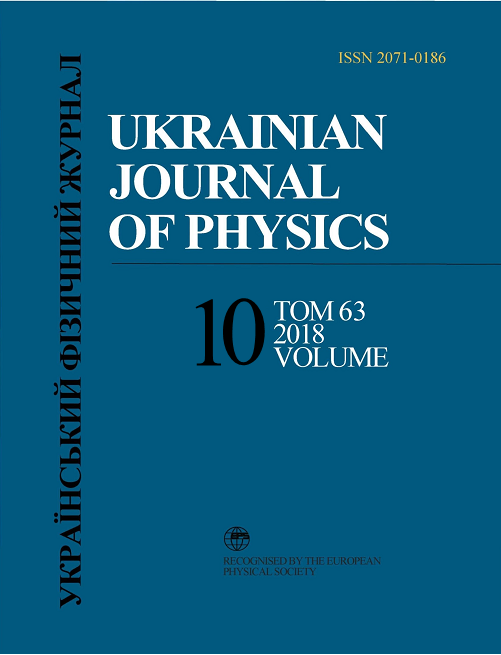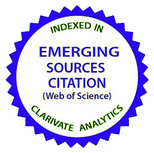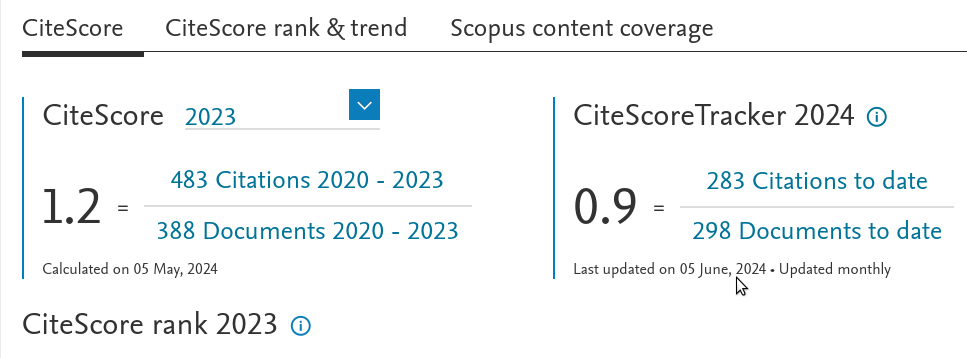Model of Postsynaptic Membrane Deactivation
DOI:
https://doi.org/10.15407/ujpe63.10.919Keywords:
nerve impulse, synapse, mediator, receptor, postsynaptic membraneAbstract
A model has been proposed to describe the deactivation of a postsynaptic membrane after its excitation by transmitting a nerve impulse across the synapse. In particular, the process of mediator release in the form of choline from the postsynaptic membrane and its diffusive excretion from the synaptic cleft are considered. The time dependence of the number of activated receptors, the dependence of the maximum number of activated receptors on the activation time, and the space-time distribution of the choline concentration in the synaptic cleft are calculated.
References
A.L. Zefirov, S.Yu. Cheranov, R.A. Giniatullin, G.F. Sitdikova, S.N. Grishin. Mediators and Synapses (KGMU, 2003) (in Russian).
A.V. Sidorov. Physiology of Intercellular Communication (BGU, 2008) (in Russian).
A.V. Chalyi, A.N. Vasilev, E.V. Zaitseva. Synaptic transmission as a cooperative phenomenon in confined systems. Cond. Matter Phys. 20, 13804 (2017). https://doi.org/10.5488/CMP.20.13804
S.O. Rizzoli, W.J. Betz. Synaptic vesicle pools. Nature Rev. Neurosci. 6, 57 (2005). https://doi.org/10.1038/nrn1583
O.M. Vasylyev, A.V. Kulish. Two-pool kinetic model of synapse activation. Zh. Fiz. Dosl. 14, 4801 (2010) (in Ukrainian).
A.N. Vasilyev, A.V. Kulish. Influence of mediator diffusion on the trigger mode of synapse operation. Biofizika 59, 373 (2014) (in Russian).
R.W. Holz, S.K.Fisher. Synaptic transmission and cellular signaling: An overview. In: Basic Neurochemistry (Elsevier, 2012), p. 235. https://doi.org/10.1016/B978-0-12-374947-5.00012-2
J. Lichtenberger, P. Fromherz. A cell-semiconductor synapse: Transistor recording of vesicle release in chromaffin cells. Biophys. J. 92, 2266 (2007). https://doi.org/10.1529/biophysj.106.096446
J. Trommershauser, R. Schneggenburger, A. Zippelius, E. Nehery. Heterogeneous presynaptic release probabilities: Functional relevance for short-term plasticity. Biophys. J. 84, 1563 (2003). https://doi.org/10.1016/S0006-3495(03)74967-4
S.I. Braichenko, O.M. Vasylyev. Modeling the postsynaptic membrane activation. Zh. Fiz. Dosl. 16, 4802 (2012).
I.C. Kleppe, H.P.C. Robinson. Determining the activation time course of synaptic AMPA receptors from openings of colocalized NMDA receptors. Biophys. J. 77, 1418 (1999). https://doi.org/10.1016/S0006-3495(99)76990-0
K. Zheng, A. Scimemi, D.A. Rusakov. Receptor actions of synaptically released glutamate: the role of transporters on the scale from nanometers to microns. Biophys. J. 95, 4584 (2008). https://doi.org/10.1529/biophysj.108.129874
A.V. Chalyi, L.M. Chernenko. Phase transition in finite-size systems and synaptic transmission. In: Dynamical Phenomena at Interfaces, Surfaces and Membranes (Nova Sci. Publ., 1993), p. 457.
A.V. Chalyi, E.V. Zaitseva. Strange attractor in kinetic model of synaptic transmission. J. Phys. Studies 11, 3, 322 (2007).
O.V. Chalyi, O.V. Zaitseva. A kinetic model of synaptic transmission on intercell interaction. Ukr. J. Phys. 54, 4, 366 (2009).
Downloads
Published
How to Cite
Issue
Section
License
Copyright Agreement
License to Publish the Paper
Kyiv, Ukraine
The corresponding author and the co-authors (hereon referred to as the Author(s)) of the paper being submitted to the Ukrainian Journal of Physics (hereon referred to as the Paper) from one side and the Bogolyubov Institute for Theoretical Physics, National Academy of Sciences of Ukraine, represented by its Director (hereon referred to as the Publisher) from the other side have come to the following Agreement:
1. Subject of the Agreement.
The Author(s) grant(s) the Publisher the free non-exclusive right to use the Paper (of scientific, technical, or any other content) according to the terms and conditions defined by this Agreement.
2. The ways of using the Paper.
2.1. The Author(s) grant(s) the Publisher the right to use the Paper as follows.
2.1.1. To publish the Paper in the Ukrainian Journal of Physics (hereon referred to as the Journal) in original language and translated into English (the copy of the Paper approved by the Author(s) and the Publisher and accepted for publication is a constitutive part of this License Agreement).
2.1.2. To edit, adapt, and correct the Paper by approval of the Author(s).
2.1.3. To translate the Paper in the case when the Paper is written in a language different from that adopted in the Journal.
2.2. If the Author(s) has(ve) an intent to use the Paper in any other way, e.g., to publish the translated version of the Paper (except for the case defined by Section 2.1.3 of this Agreement), to post the full Paper or any its part on the web, to publish the Paper in any other editions, to include the Paper or any its part in other collections, anthologies, encyclopaedias, etc., the Author(s) should get a written permission from the Publisher.
3. License territory.
The Author(s) grant(s) the Publisher the right to use the Paper as regulated by sections 2.1.1–2.1.3 of this Agreement on the territory of Ukraine and to distribute the Paper as indispensable part of the Journal on the territory of Ukraine and other countries by means of subscription, sales, and free transfer to a third party.
4. Duration.
4.1. This Agreement is valid starting from the date of signature and acts for the entire period of the existence of the Journal.
5. Loyalty.
5.1. The Author(s) warrant(s) the Publisher that:
– he/she is the true author (co-author) of the Paper;
– copyright on the Paper was not transferred to any other party;
– the Paper has never been published before and will not be published in any other media before it is published by the Publisher (see also section 2.2);
– the Author(s) do(es) not violate any intellectual property right of other parties. If the Paper includes some materials of other parties, except for citations whose length is regulated by the scientific, informational, or critical character of the Paper, the use of such materials is in compliance with the regulations of the international law and the law of Ukraine.
6. Requisites and signatures of the Parties.
Publisher: Bogolyubov Institute for Theoretical Physics, National Academy of Sciences of Ukraine.
Address: Ukraine, Kyiv, Metrolohichna Str. 14-b.
Author: Electronic signature on behalf and with endorsement of all co-authors.













